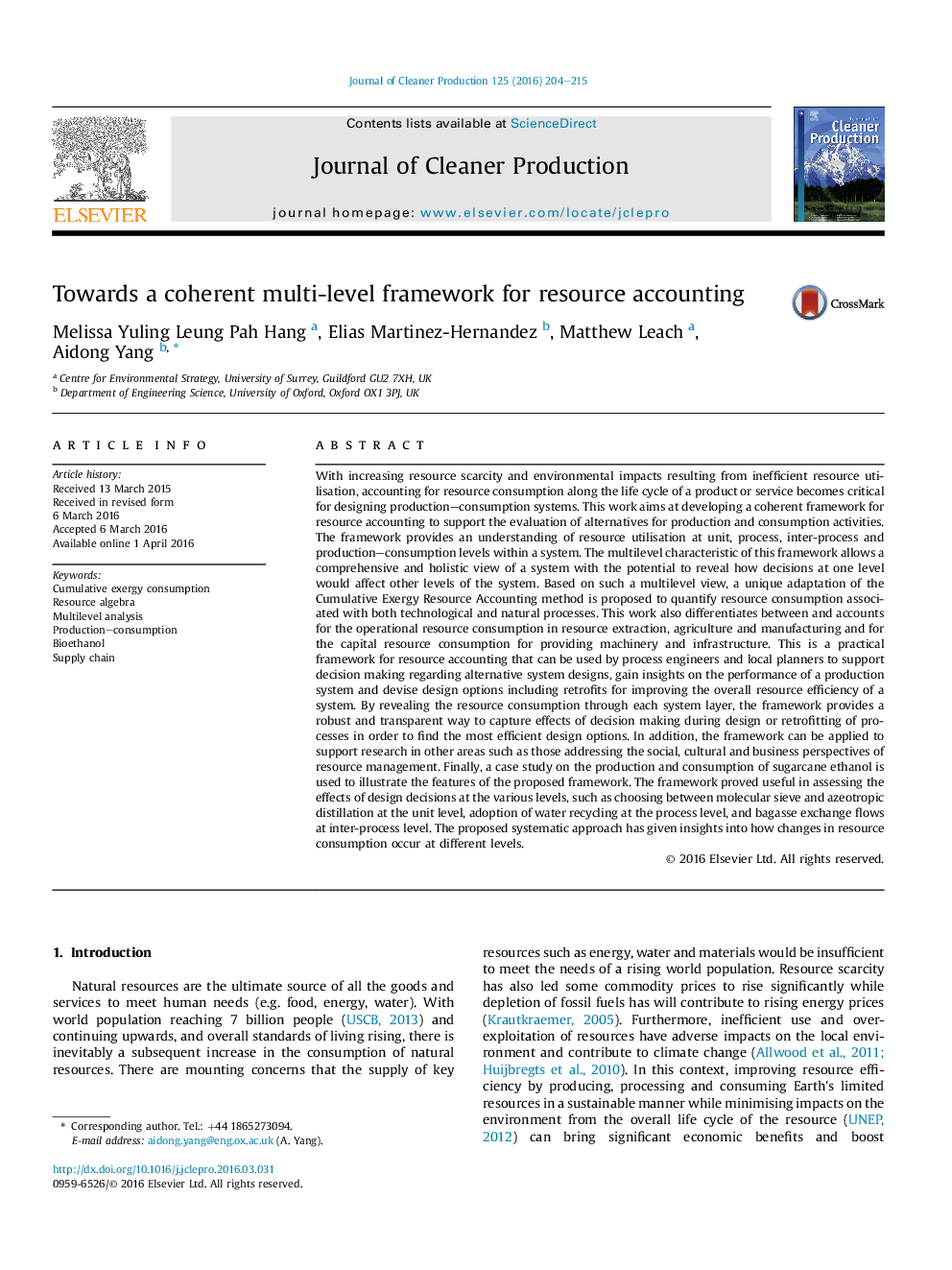| کد مقاله | کد نشریه | سال انتشار | مقاله انگلیسی | نسخه تمام متن |
|---|---|---|---|---|
| 8102221 | 1522124 | 2016 | 12 صفحه PDF | دانلود رایگان |
عنوان انگلیسی مقاله ISI
Towards a coherent multi-level framework for resource accounting
ترجمه فارسی عنوان
به چارچوب منسجم چند جانبه برای حسابداری منابع
دانلود مقاله + سفارش ترجمه
دانلود مقاله ISI انگلیسی
رایگان برای ایرانیان
کلمات کلیدی
مصرف انبوه اگزرژی، جبر منابع، تجزیه و تحلیل چندسطحی، تولید؟ مصرف، بیوتکنول، زنجیره تامین،
ترجمه چکیده
با افزایش کمبود منابع و اثرات زیست محیطی ناشی از استفاده ناکارآمد منابع، حسابداری برای مصرف منابع در طول چرخه زندگی یک محصول یا خدمات برای طراحی سیستم های تولید و مصرف حیاتی می شود. هدف از این کار توسعه یک چارچوب منسجم برای حسابداری منابع برای حمایت از ارزیابی جایگزین برای فعالیت های تولید و مصرف است. این چارچوبی درک استفاده از منابع در واحد، فرآیند، فرایندهای بین فرآیند و مصرف-تولید را در یک سیستم درک می کند. خصوصیات چند سطحی این چارچوب به دیدگاه جامع و جامع از یک سیستم می پردازد که نشان می دهد چگونه تصمیم گیری در یک سطح بر سطوح دیگر سیستم تأثیر می گذارد. بر اساس چنین دیدگاه چند سطحی، سازگاری منحصر به فرد از روش حسابداری منابع انباشتی اگزرژی برای اندازه گیری میزان مصرف منابع مرتبط با فرایندهای تکنولوژیکی و طبیعی پیشنهاد شده است. این کار همچنین بین و حسابداری برای مصرف منابع عملیاتی در استخراج منابع، کشاورزی و تولید و برای مصرف منابع سرمایه برای ارائه ماشین آلات و زیرساخت ها را متمایز می کند. این یک چارچوب عملی برای حسابداری منابع است که می تواند توسط مهندسین فرایند و برنامه ریزان محلی برای حمایت از تصمیم گیری در مورد طرح های سیستم جایگزین، به دست آوردن بینش در مورد عملکرد یک سیستم تولید و طراحی گزینه های طراحی از جمله بهینه سازی برای بهبود کلی بهره وری منابع سیستم. با آشکارسازی مصرف منابع از طریق هر لایه سیستم، چارچوب یک راه قوی و شفاف برای ضبط اثرات تصمیم گیری در هنگام طراحی یا تکمیل فرایندها برای یافتن گزینه های کارآمد طراحی فراهم می کند. علاوه بر این، چارچوب را می توان برای حمایت از پژوهش در زمینه های دیگر مانند کسانی که به دیدگاه های اجتماعی، فرهنگی و کسب و کار مدیریت منابع. در نهایت، مطالعه موردی درباره تولید و مصرف نیتروژن قند سبوس دار برای نشان دادن ویژگی های چارچوب پیشنهادی استفاده می شود. این چارچوب در ارزیابی تأثیر تصمیمات طراحی در سطوح مختلف، مانند انتخاب بین غربال مولکولی و تقطیر آسئوتروپیک در سطح واحد، تصویب مجدد بازیافت آب در سطح فرایند و جریان مبادله بوته در سطح بین فرآیند، مفید بود. رویکرد سیستماتیک پیشنهاد شده بینش ها را در مورد اینکه چگونه تغییرات در مصرف منابع در سطوح مختلف رخ می دهد، داده شده است.
موضوعات مرتبط
مهندسی و علوم پایه
مهندسی انرژی
انرژی های تجدید پذیر، توسعه پایدار و محیط زیست
چکیده انگلیسی
With increasing resource scarcity and environmental impacts resulting from inefficient resource utilisation, accounting for resource consumption along the life cycle of a product or service becomes critical for designing production-consumption systems. This work aims at developing a coherent framework for resource accounting to support the evaluation of alternatives for production and consumption activities. The framework provides an understanding of resource utilisation at unit, process, inter-process and production-consumption levels within a system. The multilevel characteristic of this framework allows a comprehensive and holistic view of a system with the potential to reveal how decisions at one level would affect other levels of the system. Based on such a multilevel view, a unique adaptation of the Cumulative Exergy Resource Accounting method is proposed to quantify resource consumption associated with both technological and natural processes. This work also differentiates between and accounts for the operational resource consumption in resource extraction, agriculture and manufacturing and for the capital resource consumption for providing machinery and infrastructure. This is a practical framework for resource accounting that can be used by process engineers and local planners to support decision making regarding alternative system designs, gain insights on the performance of a production system and devise design options including retrofits for improving the overall resource efficiency of a system. By revealing the resource consumption through each system layer, the framework provides a robust and transparent way to capture effects of decision making during design or retrofitting of processes in order to find the most efficient design options. In addition, the framework can be applied to support research in other areas such as those addressing the social, cultural and business perspectives of resource management. Finally, a case study on the production and consumption of sugarcane ethanol is used to illustrate the features of the proposed framework. The framework proved useful in assessing the effects of design decisions at the various levels, such as choosing between molecular sieve and azeotropic distillation at the unit level, adoption of water recycling at the process level, and bagasse exchange flows at inter-process level. The proposed systematic approach has given insights into how changes in resource consumption occur at different levels.
ناشر
Database: Elsevier - ScienceDirect (ساینس دایرکت)
Journal: Journal of Cleaner Production - Volume 125, 1 July 2016, Pages 204-215
Journal: Journal of Cleaner Production - Volume 125, 1 July 2016, Pages 204-215
نویسندگان
Melissa Yuling Leung Pah Hang, Elias Martinez-Hernandez, Matthew Leach, Aidong Yang,
